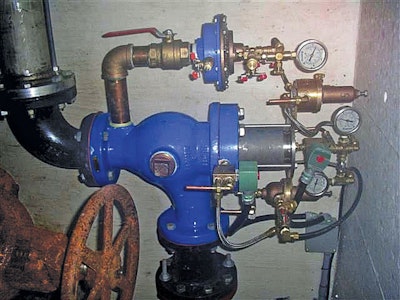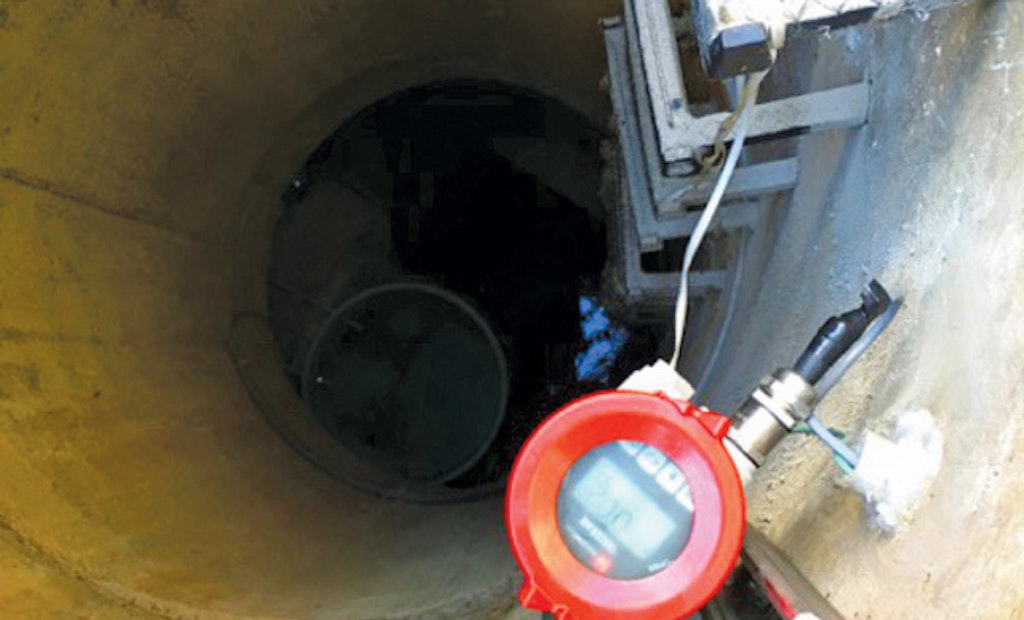Interested in Stormwater?
Get Stormwater articles, news and videos right in your inbox! Sign up now.
Stormwater + Get AlertsRadar level transmitter provides solution for combined sewer overflow
Problem: A wastewater treatment plant in Campbell, Ohio, had a narrow manhole that was 30 feet deep with an overflow pipe that was raised up 20 feet from the bottom. The customer needed to measure from the bottom of the 30-foot well up to 18 inches from the top. They were required to read all of the water going into the overflow pipe and didn’t have any space to make the measurements. The surface water was contaminated with foam, organic debris and effluent.
Solution: FLO-CORP’s solution was to mount a Tracer Air Radar Level Transmitter near the sidewall of the manhole with a clear path down to the bottom of the pit. The noncontacting radar level transmitter was recommended due to the small beam angle (less than 8 degrees) and advanced echo-processing algorithms to eliminate false return echoes from the ladder rungs, piping and sidewall buildup. The Tracer Air is ideal for difficult applications with factors such as vapor, steam, pressure, temperature change, dust and foam.
Result: The wastewater treatment plant now has the ability to measure the 30-foot manhole accurately and reliably. 877/356-5463; www.flowlineoptions.com.
Grinder keeps wipes at bay in Massachusetts pump station
Problem: As the population of Billerica, Massachusetts, grows, so has the amount of debris flowing through the area’s wastewater treatment system, especially rags and flushable wipes. This extra influent was causing undue stress and equipment damage at one of the area’s largest pump stations. The city sought a waste reduction solution to eliminate these problems. “Dealing with wipes has been nothing but a nightmare,” says Mike McCaughey, collections supervisor for Billerica. “Our Brown Street pump station has a 24-inch pipeline leading into the station, and when there’s not enough flow, rags just build up inside the pipe. Then, during periods of heavy rain, a slug of stormwater rushes through the pipeline and all the rags hit the pumps at once.” This influx of wipes and rags would also cause issues during routine cleanings of the wet well. McCaughey wanted a solution that would protect the pumps at Brown Street and the remaining pump stations downstream without inhibiting flow or requiring a major system redesign.
Solution: Jim Deluca, president of Aqua Solutions, recommended installing a Channel Monster grinder with upgraded Wipes Ready Technology from JWC Environmental for the Brown Street pump station.
Result: McCaughey found the system to be a durable, cost-effective and versatile solution. “The grinder made a huge difference,” McCaughey says. Since the installation of grinder in 2014, the need for daily pump maintenance has been eliminated. 800/331-2277; www.jwce.com.
Relief valve with surge anticipator eliminates pipe breaks
Problem: The District of Central Saanich in Victoria, British Columbia, has a widely dispersed sewage collections system with multiple lift stations that pump sewage several miles through force mains to a treatment plant. When fluids travel such long distances, there is always the potential for pressure buildups from even the slightest changes in velocity. Hard stops at the pump or power interruptions caused surges that literally blew lines out of the ground.
Solution: Singer Valve’s Pneumatic Dynamic Lifter (PDL) with surge anticipator was installed to reduce stress on the pipes. The responsive compact sewage relief valve can handle high pressures (200 psi or higher) and uses standard plant air supply to hold the valve closed. This chamber is fitted with a relief pilot that is also normally closed, providing the line pressure is lower than the setpoint. If pressure rises above the setpoint, the relief pilot opens, causing the air in the cylinder to vent, which in turn opens the valve. The anticipating surge relief function has two three-way solenoid valves to put air into the cylinder under the piston, driving the valve open on power failure. This way, when the surge returns to the pump it is not coming back to a closed system where it can cause damage; it comes back to an open valve where it can discharge safely into the storage well underneath the pump.
Result: The relief valve guaranteed no surges, eliminating the cause of pipe breakage in the system. 888/764-7858; www.singervalve.com.







